译林英语六年级下册教案
译林版小学英语教案六年级下册
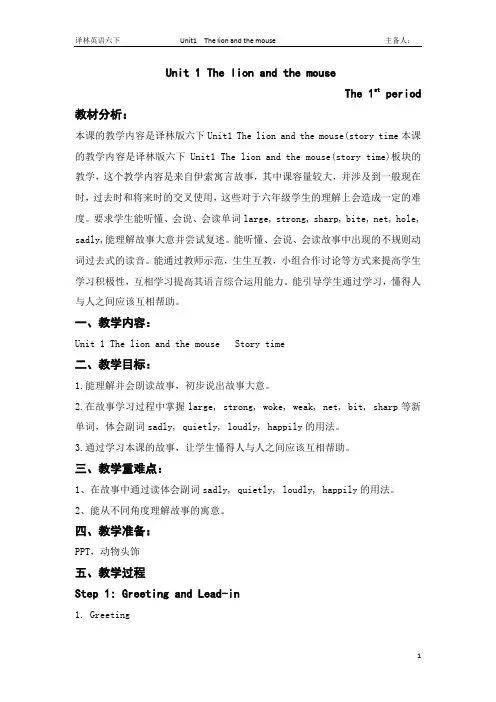
Unit 1 The lion and the mouseThe 1st period 教材分析:本课的教学内容是译林版六下Unit1 The lion and the mouse(story time本课的教学内容是译林版六下Unit1 The lion and the mouse(story time)板块的教学,这个教学内容是来自伊索寓言故事,其中课容量较大,并涉及到一般现在时,过去时和将来时的交叉使用,这些对于六年级学生的理解上会造成一定的难度。
要求学生能听懂、会说、会读单词large, strong, sharp, bite, net, hole, sadly,能理解故事大意并尝试复述。
能听懂、会说、会读故事中出现的不规则动词过去式的读音。
能通过教师示范,生生互教,小组合作讨论等方式来提高学生学习积极性,互相学习提高其语言综合运用能力。
能引导学生通过学习,懂得人与人之间应该互相帮助。
一、教学内容:Unit 1 The lion and the mouse Story time二、教学目标:1.能理解并会朗读故事,初步说出故事大意。
2.在故事学习过程中掌握large, strong, woke, weak, net, bit, sharp等新单词,体会副词sadly, quietly, loudly, happily的用法。
3.通过学习本课的故事,让学生懂得人与人之间应该互相帮助。
三、教学重难点:1、在故事中通过读体会副词sadly, quietly, loudly, happily的用法。
2、能从不同角度理解故事的寓意。
四、教学准备:PPT,动物头饰五、教学过程Step 1: Greeting and Lead-in1. GreetingT: Hi, boys and girls. Welcome back to school again.2. Learning tipsT: This is a new term now. And it’s the last term in your primary school time. So first of all, today let’s talk about your study plan for this term. What’s your study plan?3. Lead –inT: Here’s a study plan. Can you read this plan?T: Look, in this plan, the planner wants to spend more time on reading English. Indeed, reading is very important. And story reading is very good for English learning. So today, I bring you a story.Step 2 Presentation1. 30-second’s talk showT: This story is about two different animals. (PPT)The name of the story is The lion and the mouse. (课题)Before the story, I want you to be one of them and try to say something.2. PredictionT: Yes, As you all know, the lion and the mouse are very different, aren’t you? What if they met each other one day? Can you guess?T: Let’s watch a cartoon and see what happens. (学生看后预测)3. Read and orderT: Nice. Now you know what happens. Here are some sentences, but they are not in order. Can you read your story on your book quickly and put thenin order?T: Now they are in order. But here’s a problem. Even if they are in the right order, this story is still not completed. So can you read this story again and try to say three more sentences to complete this story?4. Read the story picture by pictureT: Now we ’ve got the outline of the story. Let ’s listen and read this story by picture. Please listen and try to follow what you hear. (教授: 单词 词组)5.Ask and answerT: Now we ’ve got every details of the story. Let me ask you some question and please answer me quickly.T: There are 5 questions on your book. But I want you to ask and answer more. Now you can read the story again and prepare some questions? Step 3 Consolidation1. The moral or the storyT: What does this story tell us?T: I have 3 questions to help you think in different ways.Read and try to say something,2. 3-minute ’s talk show.Step 4 Homework1. Make a study plan.2.听磁带,有感情地模仿熟读课文并尝试背诵。
译林版六年级下册英语教案-Unit2 Good habits
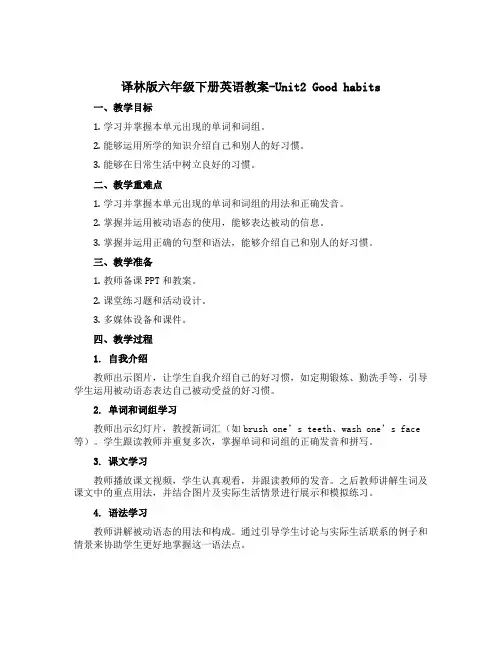
译林版六年级下册英语教案-Unit2 Good habits一、教学目标1.学习并掌握本单元出现的单词和词组。
2.能够运用所学的知识介绍自己和别人的好习惯。
3.能够在日常生活中树立良好的习惯。
二、教学重难点1.学习并掌握本单元出现的单词和词组的用法和正确发音。
2.掌握并运用被动语态的使用,能够表达被动的信息。
3.掌握并运用正确的句型和语法,能够介绍自己和别人的好习惯。
三、教学准备1.教师备课PPT和教案。
2.课堂练习题和活动设计。
3.多媒体设备和课件。
四、教学过程1. 自我介绍教师出示图片,让学生自我介绍自己的好习惯,如定期锻炼、勤洗手等,引导学生运用被动语态表达自己被动受益的好习惯。
2. 单词和词组学习教师出示幻灯片,教授新词汇(如brush one’s teeth、wash one’s face 等)。
学生跟读教师并重复多次,掌握单词和词组的正确发音和拼写。
3. 课文学习教师播放课文视频,学生认真观看,并跟读教师的发音。
之后教师讲解生词及课文中的重点用法,并结合图片及实际生活情景进行展示和模拟练习。
4. 语法学习教师讲解被动语态的用法和构成。
通过引导学生讨论与实际生活联系的例子和情景来协助学生更好地掌握这一语法点。
5. 句型学习教师讲解如何介绍别人的好习惯,如运用“What about…”这一句型,引导学生模拟对话进行练习。
6. 课堂练习学生在课堂上完成教师出的练习题,包括单选题、填空题和阅读理解题等,巩固和提高所学知识点的应用能力和学习效果。
7. 活动设计分组活动:教师将学生分成若干组,让每组学生讲述一个好习惯,其他同学则进行点评和改进建议,从而提高语言表达和交流能力。
8. 作业布置教师布置课后练习和阅读任务,督促学生复习所学知识点和掌握单词和词组的使用和发音。
五、教学总结本节课主要以自我介绍、单词和词组学习、课文学习、语法学习和句型学习为主要教学内容,通过课堂练习和活动设计,帮助学生掌握课文知识点,加强课堂互动交流和口语表达能力,切实提高英语学习的效果和质量。
译林版译林英语六年级下册全册教案及教学反思
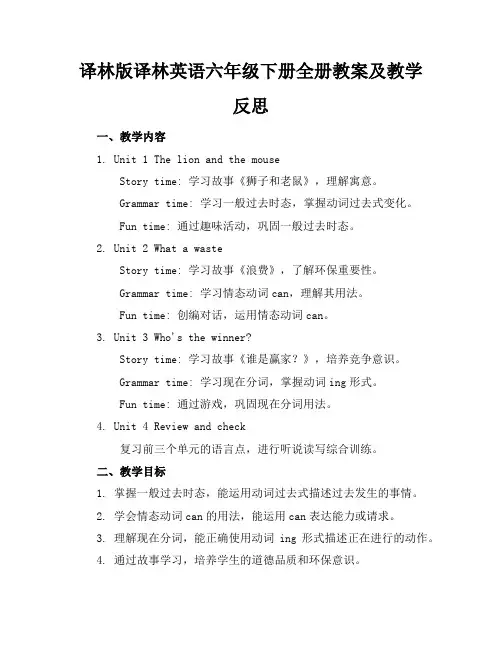
译林版译林英语六年级下册全册教案及教学反思一、教学内容1. Unit 1 The lion and the mouseStory time: 学习故事《狮子和老鼠》,理解寓意。
Grammar time: 学习一般过去时态,掌握动词过去式变化。
Fun time: 通过趣味活动,巩固一般过去时态。
2. Unit 2 What a wasteStory time: 学习故事《浪费》,了解环保重要性。
Grammar time: 学习情态动词can,理解其用法。
Fun time: 创编对话,运用情态动词can。
3. Unit 3 Who's the winner?Story time: 学习故事《谁是赢家?》,培养竞争意识。
Grammar time: 学习现在分词,掌握动词ing形式。
Fun time: 通过游戏,巩固现在分词用法。
4. Unit 4 Review and check复习前三个单元的语言点,进行听说读写综合训练。
二、教学目标1. 掌握一般过去时态,能运用动词过去式描述过去发生的事情。
2. 学会情态动词can的用法,能运用can表达能力或请求。
3. 理解现在分词,能正确使用动词ing形式描述正在进行的动作。
4. 通过故事学习,培养学生的道德品质和环保意识。
三、教学难点与重点1. 教学难点:一般过去时态、情态动词can和现在分词的运用。
2. 教学重点:动词过去式、can的用法、动词ing形式的掌握。
四、教具与学具准备1. 教具:多媒体课件、故事卡片、游戏道具。
2. 学具:英语课本、练习本、彩色笔。
五、教学过程1. 导入:通过趣味故事或游戏,引入新课。
2. 新课展示:呈现故事内容,引导学生学习。
3. 语言点讲解:详细讲解一般过去时态、情态动词can和现在分词。
4. 例题讲解:分析例题,解释解题思路。
5. 随堂练习:布置练习题,巩固所学知识。
6. 小组活动:分组讨论,创编对话或故事,运用所学语言点。
译林版六年级下英语教案
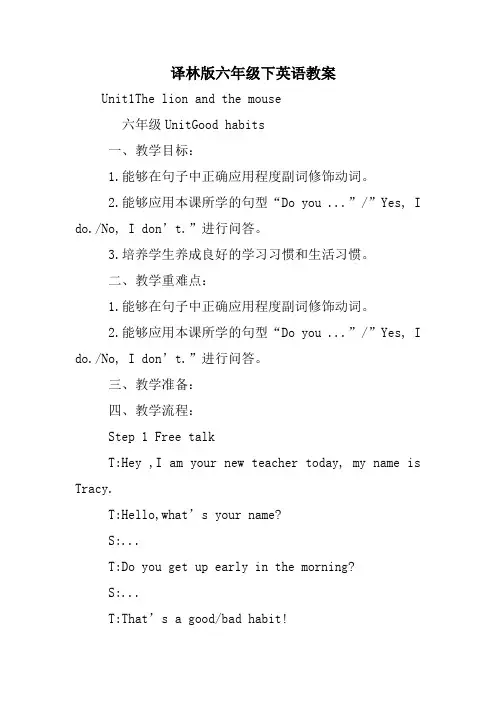
译林版六年级下英语教案Unit1The lion and the mouse六年级UnitGood habits一、教学目标:1.能够在句子中正确应用程度副词修饰动词。
2.能够应用本课所学的句型“Do you ...”/”Yes, I do./No, I don’t.”进行问答。
3.培养学生养成良好的学习习惯和生活习惯。
二、教学重难点:1.能够在句子中正确应用程度副词修饰动词。
2.能够应用本课所学的句型“Do you ...”/”Yes, I do./No, I don’t.”进行问答。
三、教学准备:四、教学流程:Step 1 Free talkT:Hey ,I am your new teacher today, my name is Tracy.T:Hello,what’s your name?S:...T:Do you get up early in the morning?S:...T:That’s a good/bad habit!T:I have some habits too,can you ask me? S:Do you have your meals in the morning?T:Yes, I do. I always .... 纸盒,单词字条、展板、调查表S:Do you read books?T:Yes, I do. I usually....S:Do you clean the roomT:yea, i do. I sometimes ....T: I have some good habits but I have bad habits too. Look at my panda eyes, i always go to bed late at night, it is a bad habit, you should go to bed early. Step PresentationT: as a good students ,we should have good habits,let’s make a good habits proposal step by step.1. Step 1 is how to ask others.You know my habits,how about you? let’s play a game. Who want to be my partner?Fun time---- T: Pick one....S: pick one...pair workT: Now ,it’s your turn, pick one picture from the envelope and practice in pairs!Magic box----T: good job,boys and girls, you can ask other about theirs’ habits.let’s have a rest.2. Step 1 is how to make.First, Pick different color papers from the box. Unit1The lion and the mouse123。
牛津译林版小学英语六年级下册 全册 教案
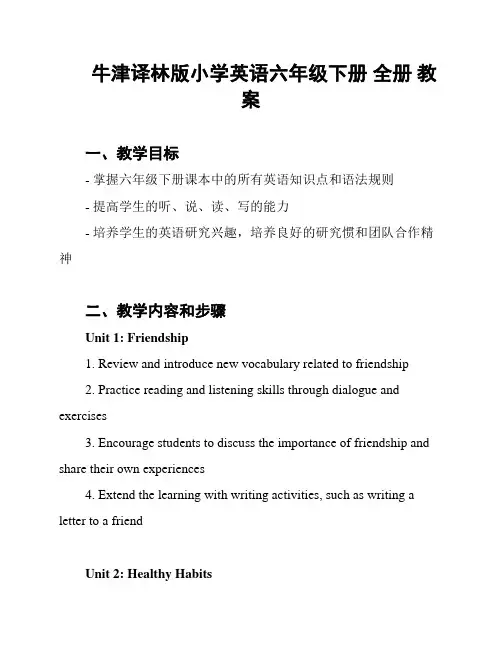
牛津译林版小学英语六年级下册全册教案一、教学目标- 掌握六年级下册课本中的所有英语知识点和语法规则- 提高学生的听、说、读、写的能力- 培养学生的英语研究兴趣,培养良好的研究惯和团队合作精神二、教学内容和步骤Unit 1: Friendship1. Review and introduce new vocabulary related to friendship2. Practice reading and listening skills through dialogue and exercises3. Encourage students to discuss the importance of friendship and share their own experiences4. Extend the learning with writing activities, such as writing a letter to a friendUnit 2: Healthy Habits1. Introduce vocabulary related to health and healthy habits2. Teach grammar structures, such as the present simple tense and adverbs of frequency3. Engage students in role play and dialogue activities to practice using the language in context4. Foster discussions on the importance of maintaining a healthy lifestyleUnit 3: Our World1. Introduce vocabulary related to nature and the environment3. Engage students in reading and listening activities about environmental issues4. Encourage students to express their opinions on protecting the environment...三、教学方法和技巧1. 多媒体辅助教学:利用投影仪、音频和视频等多媒体设备进行教学,激发学生的研究兴趣和注意力。
译林英语六年级下册全册优质教案
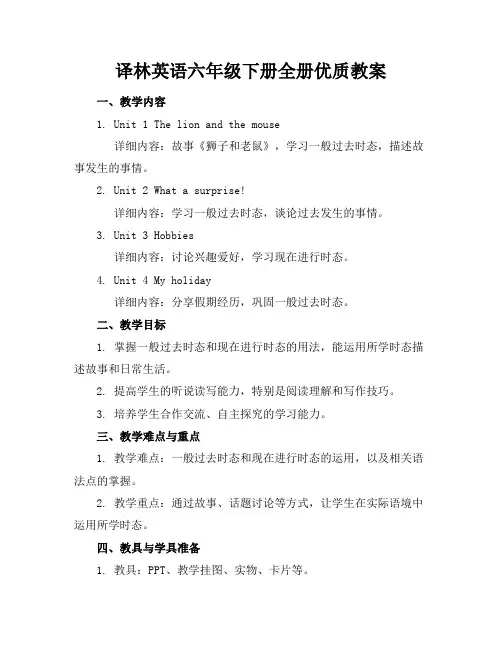
译林英语六年级下册全册优质教案一、教学内容1. Unit 1 The lion and the mouse详细内容:故事《狮子和老鼠》,学习一般过去时态,描述故事发生的事情。
2. Unit 2 What a surprise!详细内容:学习一般过去时态,谈论过去发生的事情。
3. Unit 3 Hobbies详细内容:讨论兴趣爱好,学习现在进行时态。
4. Unit 4 My holiday详细内容:分享假期经历,巩固一般过去时态。
二、教学目标1. 掌握一般过去时态和现在进行时态的用法,能运用所学时态描述故事和日常生活。
2. 提高学生的听说读写能力,特别是阅读理解和写作技巧。
3. 培养学生合作交流、自主探究的学习能力。
三、教学难点与重点1. 教学难点:一般过去时态和现在进行时态的运用,以及相关语法点的掌握。
2. 教学重点:通过故事、话题讨论等方式,让学生在实际语境中运用所学时态。
四、教具与学具准备1. 教具:PPT、教学挂图、实物、卡片等。
2. 学具:学生用书、练习册、文具等。
五、教学过程1. 导入:通过图片、歌曲、小故事等引入话题,激发学生兴趣。
2. 新课内容呈现:讲解新课内容,让学生跟读、模仿,并进行角色扮演。
3. 例题讲解:针对难点和重点进行讲解,结合实践情景让学生练习。
4. 随堂练习:设计相关练习题,巩固所学知识。
5. 小组活动:分组讨论、表演,培养学生的合作能力。
六、板书设计1. Unit 142. 重点单词和短语:根据每个单元的主题列出相关单词和短语。
3. 重点句型:用不同颜色标注一般过去时态和现在进行时态的句型。
4. 语法点:简洁明了地呈现语法点。
七、作业设计1. 作业题目:根据Unit 1的故事,编写一篇类似的短文,用一般过去时态描述。
结合Unit 2,用一般过去时态描述你上周的一个惊喜事件。
仿照Unit 3,用现在进行时态写一篇关于你的一个朋友的爱好。
根据Unit 4,写一篇关于你的假期经历的短文,用一般过去时态。
新译林版英语六年级下册全册教案
新译林版英语六年级下册全册教案一、教学内容本节课为新译林版英语六年级下册第五单元第三课时。
本课时主要学习如何用英语询问和描述某人在做某事。
教材内容主要包括:1.学习动词短语 "be doing" 和 "have fun";2. 学习如何用英语询问某人在做某事,如 "What is he/she doing? He/She is having fun.";3. 学习如何用英语描述某人在做某事,如 "I see him/her doing sth."。
二、教学目标1. 学生能够听懂、会说、会读动词短语 "be doing" 和 "have fun";2. 学生能够用英语询问和描述某人在做某事;3. 学生能够在实际情景中运用所学知识进行交际。
三、教学难点与重点重点:动词短语 "be doing" 和 "have fun" 的用法及如何用英语询问和描述某人在做某事。
难点:如何在实际情景中灵活运用所学知识进行交际。
四、教具与学具准备教具:PPT、黑板、粉笔、情景图片。
学具:课本、练习本、铅笔、橡皮。
五、教学过程1. 情景引入:教师出示一张情景图片,引导学生观察并描述图片中的人在做什么。
2. 新课导入:教师引导学生学习动词短语 "be doing" 和 "have fun" 的用法,并通过例句讲解和练习让学生熟练掌握。
3. 课堂活动:教师组织学生进行小组活动,让学生用英语询问和描述组内成员在做什么。
4. 随堂练习:教师出示练习题,让学生运用所学知识进行回答。
六、板书设计板书内容:动词短语 "be doing" 和 "have fun" 的用法,以及如何用英语询问和描述某人在做某事。
苏教牛津译林版英语六年级下册全册教案
苏教牛津译林版英语六年级下册全册教案牛津译林版英语六年级下第一课时教学设计牛津译林版英语六年级下第二课时教学设计注意降调。
(2)读句子,注意特殊疑问句中的降调!老师读一遍,学生读第二遍。
(3)编写几个特殊疑问句并读一读,注意降调!(4)Ask and answer. 将编写的特殊疑问句及答语和同伴进行对话练习。
注意疑问句中的降调。
4. 完成幻灯片中相应的课堂练习.5. Summary根据板书复述今天学习的内容:6. Homework.课堂小结这节课的教学任务目标.能复述Story time内容,会表演故事;复习巩固本课语法,形容词变副词及动词不规则变化的过去式。
本课反复回忆复述故事;反复朗读背诵动词过去式和形容词变副词,复习掌握本单元的语法;通过观看动画和朗读,掌握特殊疑问句的语调。
通过句型的反复练习,使学生掌握这些句型。
练习活动主要是两人对话,小组活动为主,学生在轻松的气氛中学到知识。
板书Unit 1 The lion and the mouse1. 形容词变副词(副词修饰动词,位于动牛津译林版英语六年级下第三课时教学设计生自由讨论并发言。
(2) 介绍Aesop’s Fables,Chinese idiom,读一读想一想自己读过的寓言故事。
(3) Let’s talk. Do you know other animalsstories ?一起来说说吧!5. Ticking time(1)两人一组互相复述故事“The lion andthe mouse”,并互相给出评价。
(2) 老师准备若干loudly, sadly…副词的卡片,任意抽取卡片,学生进行说话练习,根据掌握情况,老师给出评价。
(3)自测特殊疑问句的语调(写出5句特殊疑问句),请做出适当的评价。
6. 完成幻灯片中相应的课堂练习.7. Summary根据板书复述今天学习的内容。
课堂小结这节课的教学任务目标是能理解并会朗读Cartoon time故事并会表演;能听懂、会说、会拼读单词和短语:cheer, deep, reach,pour…into.本课为新授课,通过反复播放录音视频并跟读模仿学习词汇和朗读课文,情景表演;通过灵活多样,丰富多彩的课堂形式的进行,熟悉故事,进而可以复述故事,激发学生学习英语的兴趣,增强他们的自信心,通过教牛津译林版英语六年级下第一课时教学设计牛津译林版英语六年级下第二课时教学设计牛津译林版英语六年级下第三课时教学设计牛津译林版英语六年级下第一课时教学设计牛津译林版英语六年级下第二课时教学设计牛津译林版英语六年级下第三课时教学设计牛津译林版英语六年级下第一课时教学设计牛津译林版英语六年级下第二课时教学设计课题 Road safety单元Unit 4学科英语年级 六年级下学习 目标 1.能复述Story time 内容。
牛津译林版小学六年级下册英语全套单元教案设计(10套)
牛津译林版小学六年级下册英语全套单元教案设计(10套)Unit 1The lion and the mouse【教学目标】(1) Try to retell the story in the past tense according to the illustrations.(2) Try to understand the connection and difference between the adjectives and adverbs, experience the function of adverbs in sentences and be able to properly use them to modify verbs.(3) Learn about Chinese and foreign fables and know to express them in English Focus of the lesson and predicted area of difficulty.【教学重难点】Try to understand the connection and difference between the adjectives and adverbs, experience the function of adverbs in sentences and be able to properly use them to modify verbs.【课前准备】1.单词卡片/时间展示图;2.教学光盘或其他录音机设备;3.教学课件。
【教学过程】Step 1:Warm up& Revision1. Free talkT: Today, I want to have an interesting lesson with you. I want to see your smile. You see, I have a big smile. And I want to see your sparkling eyes. OK ?T: Last lesson, we learned a story about animals. It was “ The lion and the mouse”. Could you tell me‘Before reading the story, what are the lion and the mouse in your mind?’? For example, I think the lion is the king of the forest and the mouse is always afraid of the cat. What about you?T: After learning the story, do you still think the mouse is always weak? Why?2. Revisiona. Retell the story( work in groups)T: Do you still remember the whole story? Let’s try to retell it according to the illustrations. Here’s one tip for you. (We often use the past tense to retell the story.)T: Are you ready? This time, let’s try to retell the story in class. Each of us just say one or two sentences and let others continue.Step 2:Presentation1. Grammar timea. Read and feel ( encourage students to recall the dialogue between the lion and the mouse in the text and appreciate the feelings behind their dialogue)E.g:T: Look at the little mouse, is he dancing? No, he is shaking. How did he feel at that time?T: What about this lion? Yes,he was laughing. What made him so happy?Who’d like to be the lion and read this sentence?T: Look at this lion, was he happy? Where was he? So what did he think? How did he say?T: Finally, the mouse helped him. And they became friends. So the lion said happily. Let’s try together.b. Think and discuss ( present the first part in Grammar time and encourage students to find out the structure of these sentences)T: Can you tell me the structure of these sentences?T: What are the adverbs for? ( present two sentences to contrast and help them better understand the role of the adverb)T: Which one is better?T: Great! Here are two choices, A is that they can make things clearly and orderly. B is that they can show the actions more vividly.T: Congratulations! You are right. So we often use adverbs to modify verbs. Could you find that where do we often put adverbs?c. Look, match and thinkT: Just now, we talked about adverbs. Now let’s play a game and try to find their friends.E.g: excited--excitedlyT: Can you find some rules?d. Look, guess and say ( present some pictures and conceal some parts of the picture, then encourage students to guess )2. Culture time a. Think and choose (present three choices: A. Aesop’s Fables B. Fairy Tales C. Chinese Idiom books)T: We’ve talked about the story. But do you know where is the story from?b. Know more in details ( encourage students to talk about some stories in these two books)T: Do you find something in common?T: What about their difference? I have some stories here, please judge whether it’s Aesop’s Fables or Chinese Idioms? Are you ready?Step 3:Production1. Make a reading carda. Introduce how to make a reading cardT: Today we’ve talked about many stories. Do you like stories? Do you often read stories? What do you often do after reading a story?T: Do you know what do I usually do after reading a story?T: I’d like to make a reading card.( present one reading card about the lion and the mouse.)T:Do you want to make one by yourself?T: First, you can choose one story you like. Then take out the card you’ve prepared before class. Next write down something about the story, for example, the main characters, your favourite characters and so on.2. Make a reading card by yourself3. Share in class4. Stick reading card to the blackboardT: Wow, you did a good job! It’s really a wonderful reading wall. As we all know, reading is fun. Reading makes us wise. I hope you will likereading and keep this good habits to enrich your life.Step 4:Homeworka. Read and copy the adverbs we learned in class.b. Surf the Internet and learn more about adverbs.c. Read more animal stories after class.【板书设计】Unit 1The lion and the mousehappily sadly loudly quietly sadly【教学反思】教师在单词或词组的教学中,不能只是教读单词或词组。
译林版英语六年级下册Unit2 Good habits 教案
译林版英语六年级下册Unit2 Good habits 教案一、教学目标1.掌握本课时的单词和短语。
2.听、说、读、写本课时的故事和对话。
3.了解交通规则,养成良好的交通安全习惯。
二、教学内容1. 单词和短语1.traffic light2.crosswalk3.pedestrian4.car5.stop6.go7.wait8.safe9.dangerous10.habit2. 故事和对话本课时的故事和对话主要围绕交通安全习惯展开,以培养学生的交通安全意识和良好习惯。
3. 交通规则介绍基本交通规则,如行人应走人行道,遇到红灯停,遇到绿灯走等。
4. 交通安全意识通过故事和对话的讲解,培养学生的交通安全意识,增强学生的交通安全知识。
三、教学方法1.情境教学法:通过故事情境和对话情境来引导学生学习和理解。
2.归纳法:通过解释单词和短语的含义,让学生通过归纳的方式掌握更多相关单词和短语。
3.听说读写训练法:通过多种训练方式,培养学生听说读写的能力,帮助学生更好地理解和掌握知识。
四、教学步骤第一步:导入通过文字、图片等多种方式,让学生对本课时的主题有所了解,调动学生的学习兴趣。
第二步:单词和短语通过灵活的方式引导学生掌握本课时的单词和短语,如通过分类、图片、句子等方式。
第三步:故事和对话通过故事和对话的讲解,让学生了解和学习交通安全习惯,培养学生的交通安全意识。
第四步:交通规则通过讲解基本的交通规则,让学生了解和掌握交通常识,如何在日常生活中保护自己。
第五步:练习通过听说读写等多种方式,让学生巩固所学的知识和技能。
第六步:总结通过小组合作或个人发言的形式,让学生回顾所学知识,总结本课的重点和难点。
五、教学评价1.观察学生的听说读写能力,了解学生的学习情况。
2.通过小组合作或个人发言等方式,了解学生对本课的理解和掌握情况。
3.提供多种评价方式,如测验、考试等,评价学生的学习效果。
- 1、下载文档前请自行甄别文档内容的完整性,平台不提供额外的编辑、内容补充、找答案等附加服务。
- 2、"仅部分预览"的文档,不可在线预览部分如存在完整性等问题,可反馈申请退款(可完整预览的文档不适用该条件!)。
- 3、如文档侵犯您的权益,请联系客服反馈,我们会尽快为您处理(人工客服工作时间:9:00-18:30)。
T: It’s different from English football or American footb all. There are 18 players in an Australian football team.
They use an oval ball, not a round ball. It’s a very exciting game. Players can kick the ball or carry or h it the ball with the hand.
Is this a beautiful building Ss: Yes.
T: It’s an opera house. It’s in Sydney, the biggest ci ty of Australia. Ss: Sydney.
T: The Sydney Opera House is the most famous place in S ydney. It’s a cultural centre for concerts, dramas and operas.
3. Team work
S1: The kangaroo is a large animal. It’s brown. It has
a small head and a big body. Its front legs are short . Its back legs are long and strong. It can jump far a nd high. It has a long tail.
S2: The koala is small. It’s grey. It has large ears. It has no tail. It lives in trees and eats leaves.
4. Introduction the Sydney Opera House
5. Free talk
How did you find out about Australia
Did you go to the library
Did you search on the Internet
Do you have a friend or a relative in Australia
6. Read the text
Who Where
Where is Liu Tao
What is Liu Tao doing
What does the article talk about
Do you think Australia is an interesting country
Step 3 Practice
1. reading
2. retell the text
T: How will Mike find out about Australia
S1: He’ll ask his e-friend in Australia. T: What about Wang Bing
S2: He’ll ask Mr Green. He comes from Australia. T: What about Liu Tao
S3: He’ll read about Australia on the Internet. T: How about Yang Ling
S4: She’ll go to the library and look for books and ma gazines about Australia.
3. Team work。
